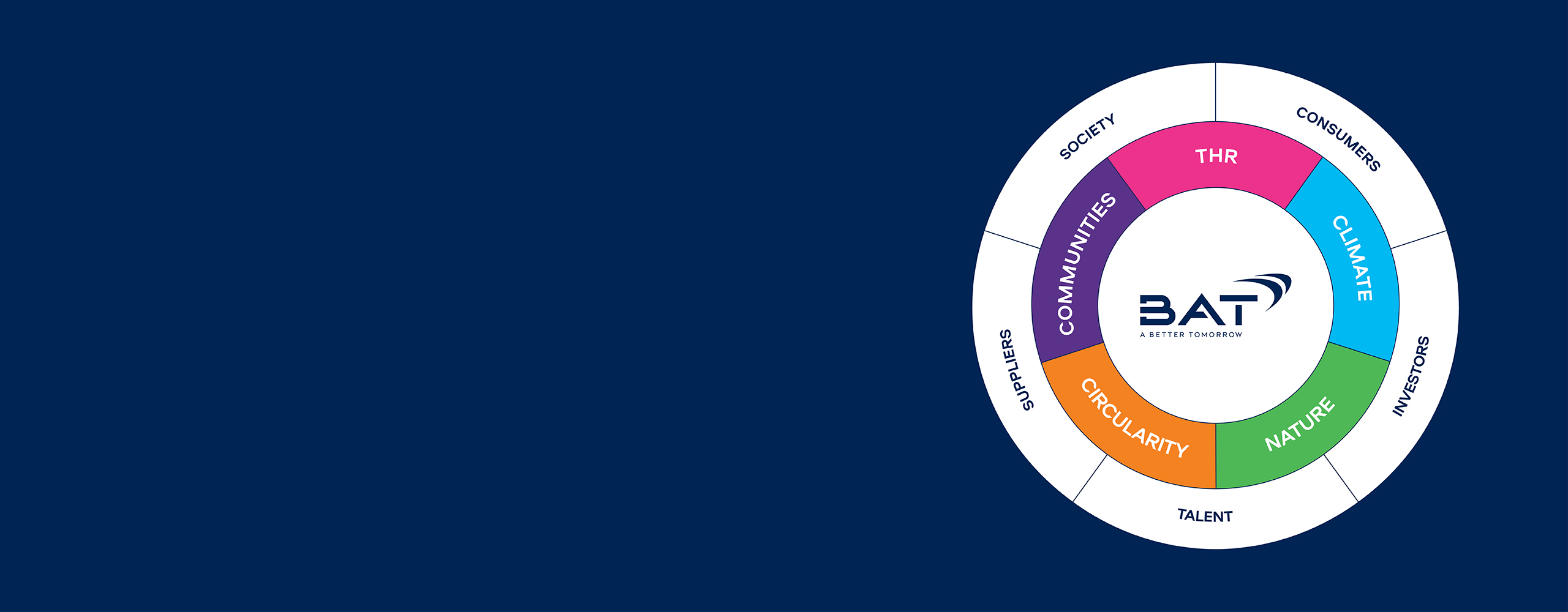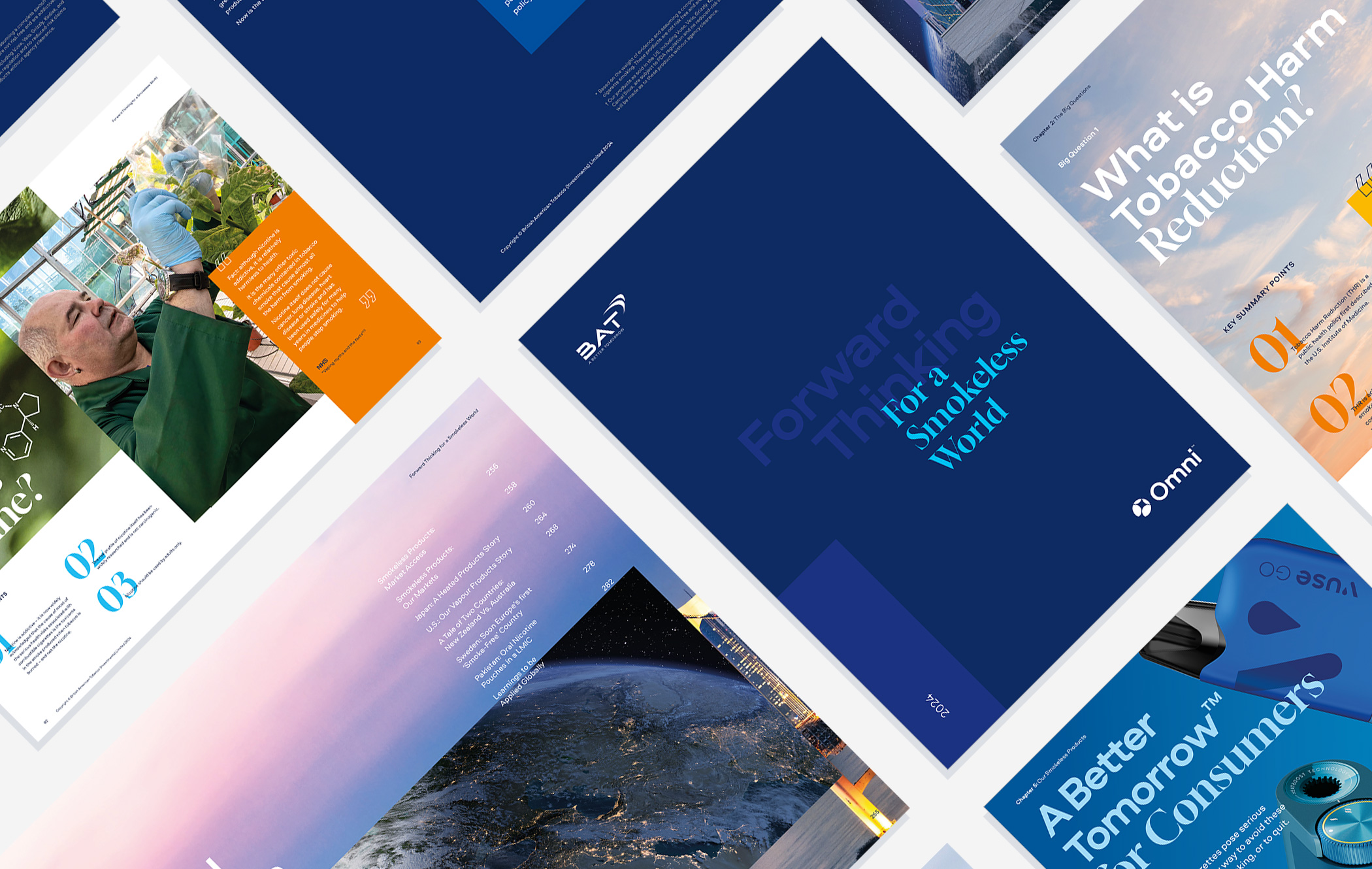Our sustainability strategy
We seek to take a leading role in tackling the biggest global issues in sustainability.
We aim to do this by responsibly Building a Smokeless World, reducing our use of natural resources and delivering our climate goals as we transition to A Better Tomorrow™. We strive to create a meaningful impact in the communities where we operate and inspire all our people to drive change.
We have refined our Group sustainability strategy
In order to better address our material sustainability topics and continue delivering value to our stakeholders, we have refined our Group sustainability strategy.
By engaging with a cross-section of stakeholder groups, we have gained a better understanding of our challenges and opportunities, resulting in the identification of the five strategic impact areas, outlined below.
These areas are supported by external reporting, stakeholder engagement and responsible business practices, guiding our future sustainability targets and ambitions.
Our strategy reflects what's important to our employees, consumers, communities, investors, suppliers, and business partners.
Our Sustainability Strategy focuses on five strategic impact areas:
Over the past decade, we have transformed our business and made significant progress on our goals. However, Building a Smokeless World is not without its roadblocks.
We believe that progressive, evidence-based regulation – supported by meaningful enforcement – is the key to reducing smoking rates.
We seek to engage with public health authorities and regulators, to support the development of policies and strategies that balance Tobacco Harm Reduction objectives with key concerns, such as underage access, environmental impacts and product safety.
2024 Sustainability Highlights
Launched Omni™, our evidence-based manifesto for change, which captures our commitment and progress towards creating A Better Tomorrow™ by Building a Smokeless World.
Updated our Responsible Marketing Principles (RMP) to reflect regulatory developments, our product portfolio and stakeholder expectations.
Underlined our position on underage access, product safety and regulatory enforcement through the publication of our ‘Commitment to Responsible Vaping Products’1.
Tracking Progress
50% of our revenue from Smokeless products by 2035
% of revenue from Smokeless products
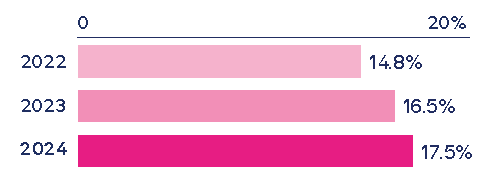
50 million Smokeless product consumers by 20301
Number of consumers‡ (millions) excluding Russia and Belarus
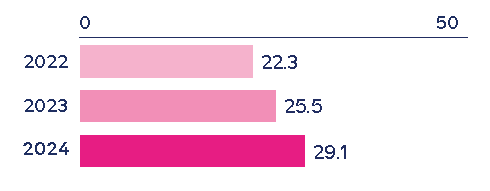
Full compliance with marketing Regulations
Number of incidents of non-compliance with marketing regulations resulting in a fine or penalty
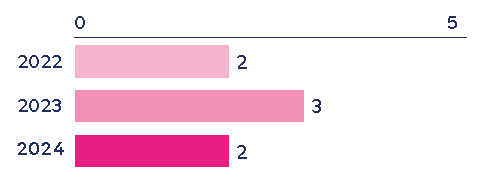
We continue to transition towards a low carbon economy by reducing our Scope 1 and 2 GHG emissions through improving energy efficiencies and increasing renewable energy use where available.
We also continue to engage suppliers through our supplier enablement programme to tackle Scope 3 GHG emissions.
In line with our climate transition efforts, we continue to focus on responsible sourcing practices and innovative product design to reduce our carbon footprint.
2024 Sustainability Highlights
Progressed towards our Scope 1 and 2 emission reduction targets. Energy reduction initiatives and increasing the use of renewable fuels resulted in a 42.6% reduction in these emissions versus our 2020 baseline.
Reduced our total Scope 3 GHG emissions by 11% year-on-year. 23.5% of our suppliers of purchased goods and services by spend have now set Science Based Targets, an 8.5 percentage points increase versus 2023.
Submitted our Net Zero Greenhouse Gas (GHG) emissions targets for validation to the Science Based Targets initiative (SBTi), in line with our climate transition efforts.
Tracking Progress
50% absolute reduction in Scope 1 and 2 GHG emissions by 2030 versus 2020 baseline2
% change in emissions relative to baseline
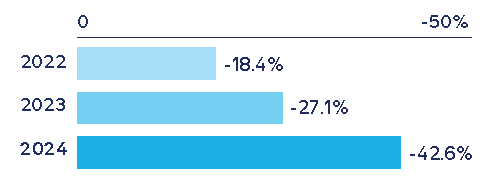
30.3% absolute reduction in Scope 3 Forest, Land and Agriculture (FLAG) GHG emissions by 2030 versus 2020 baseline2
% change in emissions relative to baseline
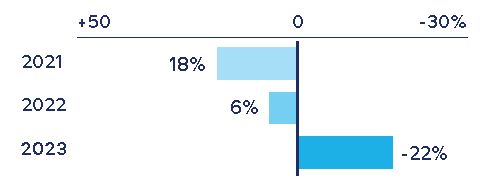
42% absolute reduction in Scope 3 Industrial (non-FLAG) GHG emissions by 2030 versus 2020 baseline2
% change in emissions relative to baseline
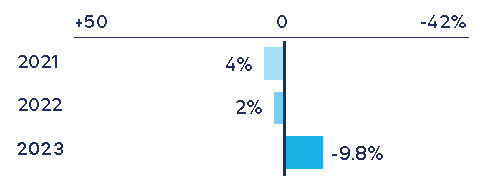
For many years, our Global Leaf Agronomy Development (GLAD) centre has worked with our directly contracted farmers and Leaf suppliers to promote improved agricultural technologies and practices.
Adoption of technology in agriculture is a core part of our nature strategy.
We are investing in AI-driven tools to accelerate the analysis of agricultural data, to help farmers increase yields, reduce costs and minimise their environmental impact.
2024 Sustainability Highlights
Introduced a satellite monitoring system in Brazil to detect potential deforestation or conversion cases by tracking forest cover changes over time.
Developed a regenerative agriculture framework which will be piloted in 2025. The framework includes a methodology for assessing and prioritising local risks and the monitoring of progress on the regeneration of the farmland ecosystem.
Achieved our 2025 target for reduction in water withdrawn in 2023, two years ahead of schedule. We continue to work on maintaining this target, achieving a 47.4% reduction in 2024 (versus our 2017 baseline).
Tracking Progress
Deforestation and Conversion Free tobacco supply chain by 2025
% wood used in our Thrive Supply Chain3 with Deforestation and Conversion Free (DCF) Status
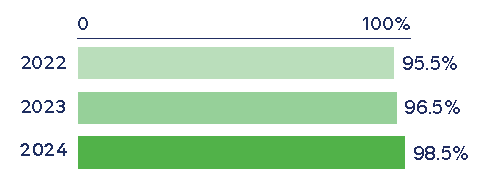
Deforestation Free pulp and paper supply chain by 2025
% of pulp and paper materials sourced with low risk of deforestation
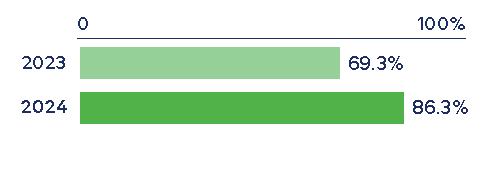
35% reduction in water withdrawn by 2025 versus 2017 baseline
% reduction in water withdrawal relative to base year
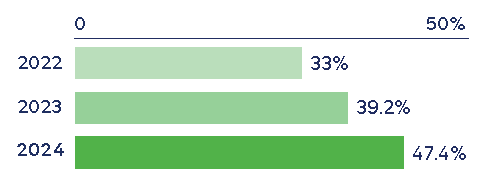
Transitioning to a portfolio of Smokeless products presents challenges, particularly in relation to plastic waste.
Our focus is on prioritising the use of materials that are sustainably produced and have a lower carbon footprint.
Our corporate venturing arm, Btomorrow Ventures (BTV), actively scouts for and collaborates with startups to identify sustainable materials as well as solutions for waste reduction and resource recovery.
We intend to design our product portfolio with circularity in mind and educate our consumers on its value.
2024 Sustainability Highlights
Introduced and began testing a set of ecodesign principles, which will provide insights to support the reduction of our environmental impacts across the product life cycle.
Launched in France, Ireland, Denmark, Sweden and the UK, two variants of Velo cans that were certified by the International Sustainability and Carbon Certification (ISCC), for using bio-plastic or Post-Consumer Resin (PCR) plastic through a mass-balance approach2.
Partnered with a waste management company to pilot a collection and recycling programme in Nottinghamshire in the UK for used vapour products.
Tracking Progress
25% reduction in waste generated in own operations by 2025 versus 2017 baseline
% reduction in operational waste generated
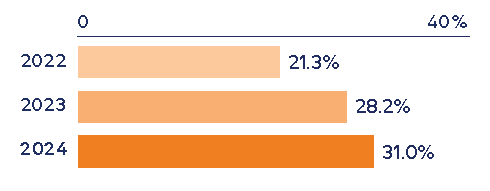
100% packaging to be reusable, recyclable or compostable where facilities exist by 2025
% of packaging reusable, recyclable or compostable
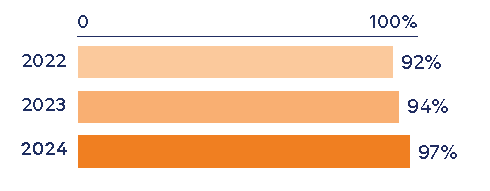
Less than 1% of our operational waste going to landfill by 2025
% of operational waste going to landfill
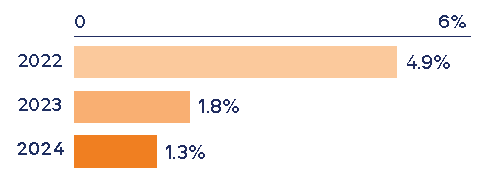
Our global footprint covers multiple supply chains, from agriculture to electronics and manufacturing.
We support our farmers to enhance their livelihoods and build resilience, while keeping in mind our ambition to transition to a Smokeless World.
We seek to responsibly source materials and respect the rights of our communities.
Our direct employees are an integral part of our communities. We continue to build on our culture so that everyone feels welcome and valued for their unique contribution at work.
2024 Sustainability Highlights
Revised our living income methodology to better represent living costs in rural areas and are in the process of co-creating action plans with suppliers to target key income drivers for farmers.
In response to our growing electronics supply chain, we continue to work with the Responsible Business Alliance (RBA) as a Supporter Member. This gives us access to the Responsible Mineral Initiative and RBA-approved auditors who conduct on-site labour audits of our suppliers.
Maintained our year-on-year consistency in compensating men and women within 1% of one another, as well as Ethnically Diverse3 and Non-ethnically Diverse3 groups within 1% of one another for performing the same work or work of equal value.
Tracking Progress
Aiming for zero child labour incidents in our tobacco supply chain by 2025
% of incidents of child labour identified and reported as resolved by end of the growing season
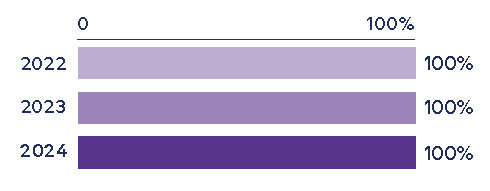
100% of product materials and higher-risk indirect suppliers having an independent labour audit within a three-year cycle by 2025
% suppliers undergoing labour audits during the last three years
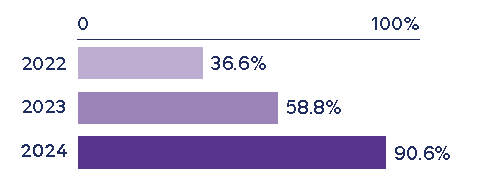
Increase the proportion of women on Senior Leadership teams‡ to 40% by 2025
% female representation on Senior Leadership teams
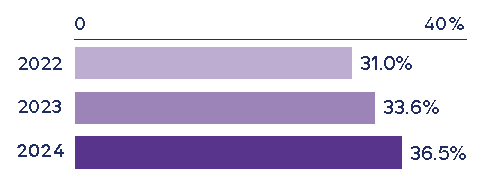
Notes:
‡ Find out more: Refer to the BAT 'Reporting Criteria' for an overview of our sustainability performance data at bat.com/reporting.
- In 2024, we enhanced our reporting methodology by increasing the use of data obtained from consumer panels compared to estimations. In the prior year (2023) we reported 23.9 million consumers. The restated value is 25.5 million consumers. Refer to the BAT 'Reporting Criteria' for our full methodology: bat.com/reporting.
- Compared to a 2020 baseline. Our near-term 2030 science-based targets comprise a 50% reduction in Scope 1 and 2 GHG emissions. The Scope 3 Industrial (non-FLAG) GHG emissions target includes purchased goods and services, upstream transportation and distribution, use of sold products, and end-of-life treatment of sold products. The Scope 3 FLAG GHG emissions target includes FLAG emissions and removals. Combined, these targets comprised 77% of Scope 3 emissions in 2020. Due to the complexity of consolidating Scope 3 data from our suppliers and value chain, we report Scope 3 data one year behind other metrics. Refer to the BAT 'Reporting Criteria' for our full methodology: bat.com/reporting.
- Our ambitions cover all tobacco we purchase for our products (‘tobacco supply chain’); which is used in our combustibles, Traditional Oral and Heated Products. Our metrics, however, derive data from our annual Thrive assessment, which includes our directly contracted farmers and those of our third-party suppliers, which represented over 93% of the tobacco we purchased by volume in 2024 (‘Thrive Supply Chain’).
